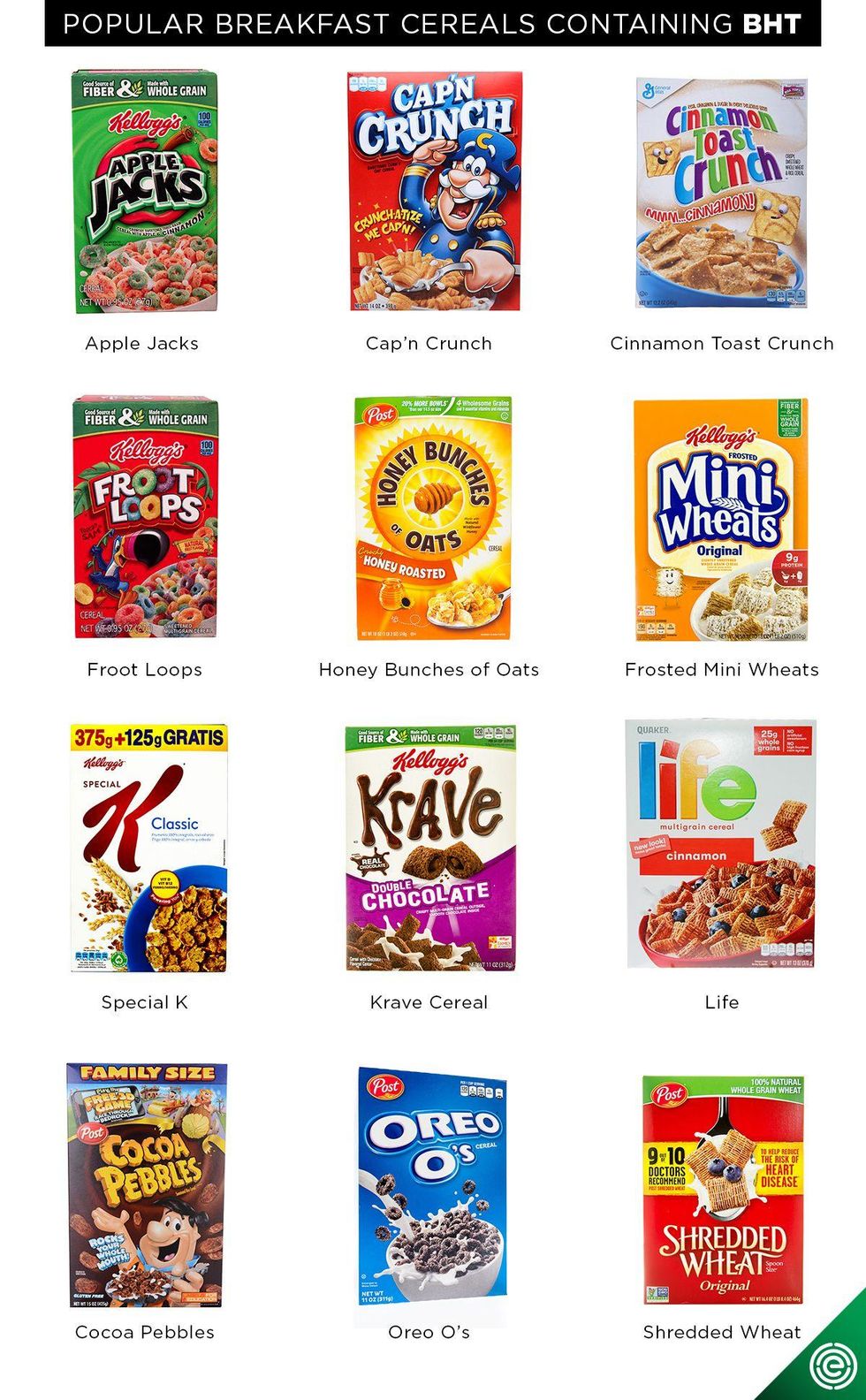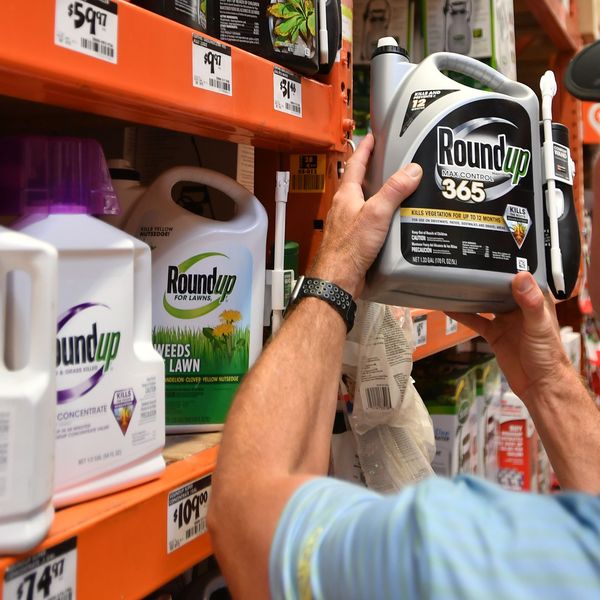
An EWG study found that children's cereal has, on average, over 40 percent more sugar than cereal marketed to adults.
Harmful Ingredients in 'Healthy' Breakfast Cereals
A diet high in ultra-processed food is linked to an increased risk of depression, obesity, Type 2 diabetes, heart disease, stroke and cancer.
Many breakfast cereals claim to be a healthy way to start the day. Their boxes feature cute, colorful characters and catchy slogans that attract children, and their promise of a "complete" breakfast with whole grains, fiber and vitamins captures adults' attention.
Cereal can be part of a balanced and nutritious breakfast. But many contain excess sugar, potentially harmful additives like food dye and added nutrients that undermine their nutritional value.
Sugars and added vitamins
Breakfast cereals, especially those marketed to children, often contain large amounts of sugar. An EWG study found that children's cereal has, on average, over 40 percent more sugar than cereal marketed to adults. A single serving of the most sugary products can exceed 60 percent of the maximum daily amount recommended by health authorities.
Many breakfast cereals also have excess added vitamins and minerals. Added micronutrients like vitamin A, zinc and niacin in a cereal might be a draw. But too much of a good thing can be harmful: A 2014 study shows nearly half of all children ages 2 to 8 consume more than the "tolerable upper intake levels" for vitamin A, zinc and niacin. Overconsumption can lead to health problems like brittle nails, hair loss, anemia and suppressed immune function.
Food additives
Many popular breakfast cereals contain potentially harmful food additives like butylated hydroxyanisole, or BHA, and butylated hydroxytoluene, or BHT.
BHA and BHT are added to well-known brands such as Cap'n Crunch, Apple Jacks, and Froot Loops to prolong their shelf life. The additives have been shown to cause hormone disruption, harm the reproductive system and potentially increase risk of cancer.
These additives continue to be allowed in the food we eat because of the Food and Drug Administration's outdated generally recognized as safe, or GRAS, rule loophole. The purpose of the GRAS rule was to allow ingredients to skip regulatory approval only if they're known to be safe. But it's allowed manufacturers, not the FDA, to certify their own ingredients as safe.
Food dyes are also frequently found in cereals. For instance, Red 40 - shown to cause behavioral problems in children--can be found in Froot Loops, Apple Jacks and Lucky Charms.

Organic versus conventional
Most packaged breakfast cereals are ultra-processed. EWG recommends limiting consumption of these foods, whether organic or conventional. A diet high in ultra-processed food is linked to an increased risk of depression, obesity, Type 2 diabetes, heart disease, stroke and cancer.
When you do want to consume ultra-processed cereals, picking organic options can help you to avoid some of these health concerns.
A recent EWG peer-reviewed study analyzed nutrition and ingredient information for more than 8,200 organic and 72,200 conventional foods sold in the U.S. in 2019 and 2020. It found organic packaged food contains fewer ultra-processed ingredients and potentially harmful food additives, and has a better overall nutritional profile, with less added sugar.
Unlike conventional packaged foods, organic packaged foods must be formulated in compliance with robust standards set by independent and government experts.
To find healthier cereal choices, check out EWG's Food Scores database, which rates food items based on concerns about nutrition, ingredients and processing.
An Urgent Message From Our Co-Founder
Dear Common Dreams reader, The U.S. is on a fast track to authoritarianism like nothing I've ever seen. Meanwhile, corporate news outlets are utterly capitulating to Trump, twisting their coverage to avoid drawing his ire while lining up to stuff cash in his pockets. That's why I believe that Common Dreams is doing the best and most consequential reporting that we've ever done. Our small but mighty team is a progressive reporting powerhouse, covering the news every day that the corporate media never will. Our mission has always been simple: To inform. To inspire. And to ignite change for the common good. Now here's the key piece that I want all our readers to understand: None of this would be possible without your financial support. That's not just some fundraising cliche. It's the absolute and literal truth. We don't accept corporate advertising and never will. We don't have a paywall because we don't think people should be blocked from critical news based on their ability to pay. Everything we do is funded by the donations of readers like you. Will you donate now to help power the nonprofit, independent reporting of Common Dreams? Thank you for being a vital member of our community. Together, we can keep independent journalism alive when it’s needed most. - Craig Brown, Co-founder |
Many breakfast cereals claim to be a healthy way to start the day. Their boxes feature cute, colorful characters and catchy slogans that attract children, and their promise of a "complete" breakfast with whole grains, fiber and vitamins captures adults' attention.
Cereal can be part of a balanced and nutritious breakfast. But many contain excess sugar, potentially harmful additives like food dye and added nutrients that undermine their nutritional value.
Sugars and added vitamins
Breakfast cereals, especially those marketed to children, often contain large amounts of sugar. An EWG study found that children's cereal has, on average, over 40 percent more sugar than cereal marketed to adults. A single serving of the most sugary products can exceed 60 percent of the maximum daily amount recommended by health authorities.
Many breakfast cereals also have excess added vitamins and minerals. Added micronutrients like vitamin A, zinc and niacin in a cereal might be a draw. But too much of a good thing can be harmful: A 2014 study shows nearly half of all children ages 2 to 8 consume more than the "tolerable upper intake levels" for vitamin A, zinc and niacin. Overconsumption can lead to health problems like brittle nails, hair loss, anemia and suppressed immune function.
Food additives
Many popular breakfast cereals contain potentially harmful food additives like butylated hydroxyanisole, or BHA, and butylated hydroxytoluene, or BHT.
BHA and BHT are added to well-known brands such as Cap'n Crunch, Apple Jacks, and Froot Loops to prolong their shelf life. The additives have been shown to cause hormone disruption, harm the reproductive system and potentially increase risk of cancer.
These additives continue to be allowed in the food we eat because of the Food and Drug Administration's outdated generally recognized as safe, or GRAS, rule loophole. The purpose of the GRAS rule was to allow ingredients to skip regulatory approval only if they're known to be safe. But it's allowed manufacturers, not the FDA, to certify their own ingredients as safe.
Food dyes are also frequently found in cereals. For instance, Red 40 - shown to cause behavioral problems in children--can be found in Froot Loops, Apple Jacks and Lucky Charms.

Organic versus conventional
Most packaged breakfast cereals are ultra-processed. EWG recommends limiting consumption of these foods, whether organic or conventional. A diet high in ultra-processed food is linked to an increased risk of depression, obesity, Type 2 diabetes, heart disease, stroke and cancer.
When you do want to consume ultra-processed cereals, picking organic options can help you to avoid some of these health concerns.
A recent EWG peer-reviewed study analyzed nutrition and ingredient information for more than 8,200 organic and 72,200 conventional foods sold in the U.S. in 2019 and 2020. It found organic packaged food contains fewer ultra-processed ingredients and potentially harmful food additives, and has a better overall nutritional profile, with less added sugar.
Unlike conventional packaged foods, organic packaged foods must be formulated in compliance with robust standards set by independent and government experts.
To find healthier cereal choices, check out EWG's Food Scores database, which rates food items based on concerns about nutrition, ingredients and processing.
Many breakfast cereals claim to be a healthy way to start the day. Their boxes feature cute, colorful characters and catchy slogans that attract children, and their promise of a "complete" breakfast with whole grains, fiber and vitamins captures adults' attention.
Cereal can be part of a balanced and nutritious breakfast. But many contain excess sugar, potentially harmful additives like food dye and added nutrients that undermine their nutritional value.
Sugars and added vitamins
Breakfast cereals, especially those marketed to children, often contain large amounts of sugar. An EWG study found that children's cereal has, on average, over 40 percent more sugar than cereal marketed to adults. A single serving of the most sugary products can exceed 60 percent of the maximum daily amount recommended by health authorities.
Many breakfast cereals also have excess added vitamins and minerals. Added micronutrients like vitamin A, zinc and niacin in a cereal might be a draw. But too much of a good thing can be harmful: A 2014 study shows nearly half of all children ages 2 to 8 consume more than the "tolerable upper intake levels" for vitamin A, zinc and niacin. Overconsumption can lead to health problems like brittle nails, hair loss, anemia and suppressed immune function.
Food additives
Many popular breakfast cereals contain potentially harmful food additives like butylated hydroxyanisole, or BHA, and butylated hydroxytoluene, or BHT.
BHA and BHT are added to well-known brands such as Cap'n Crunch, Apple Jacks, and Froot Loops to prolong their shelf life. The additives have been shown to cause hormone disruption, harm the reproductive system and potentially increase risk of cancer.
These additives continue to be allowed in the food we eat because of the Food and Drug Administration's outdated generally recognized as safe, or GRAS, rule loophole. The purpose of the GRAS rule was to allow ingredients to skip regulatory approval only if they're known to be safe. But it's allowed manufacturers, not the FDA, to certify their own ingredients as safe.
Food dyes are also frequently found in cereals. For instance, Red 40 - shown to cause behavioral problems in children--can be found in Froot Loops, Apple Jacks and Lucky Charms.

Organic versus conventional
Most packaged breakfast cereals are ultra-processed. EWG recommends limiting consumption of these foods, whether organic or conventional. A diet high in ultra-processed food is linked to an increased risk of depression, obesity, Type 2 diabetes, heart disease, stroke and cancer.
When you do want to consume ultra-processed cereals, picking organic options can help you to avoid some of these health concerns.
A recent EWG peer-reviewed study analyzed nutrition and ingredient information for more than 8,200 organic and 72,200 conventional foods sold in the U.S. in 2019 and 2020. It found organic packaged food contains fewer ultra-processed ingredients and potentially harmful food additives, and has a better overall nutritional profile, with less added sugar.
Unlike conventional packaged foods, organic packaged foods must be formulated in compliance with robust standards set by independent and government experts.
To find healthier cereal choices, check out EWG's Food Scores database, which rates food items based on concerns about nutrition, ingredients and processing.

